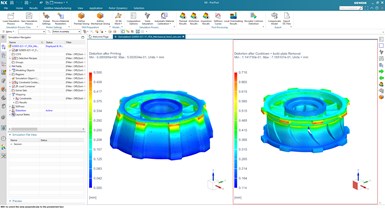Sintavia, Siemens Collaborate on AM Software
Sintavia to provide software testing and technical feedback in exchange for access to pre-released Siemens additive manufacturing software.

Simulation designed by Sintavia of an aerospace nozzle guide vane ring, both with and without supports, using Siemens Xcelerator simulation software.
As part of the three-year agreement, the two companies will collaborate on joint sales and marketing activities, and plan to organize events at Sintavia’s facility to showcase Siemens’ AM solution in an industrialized additive production environment. “The end-to-end solution that Siemens has been developing is absolutely essential to making additive a viable manufacturing process,” says Brian Neff, Sintavia CEO.
Neff stresses that the value of the Siemens AM solution goes beyond digitally connecting the various phases of the AM process. “We’ve developed a lot of tribal knowledge on how to deliver quality 3D-printed metal parts,” he says. “But we recognize that we can’t just rely on individual expertise to meet the accelerating demand in aerospace for additive manufacturing. We need software to codify the processes we undertake, and not just connect them in a digital thread, but automate them, take our know-how and have it drive activities in the background, so we can achieve optimal efficiency.”
The collaboration with Sintavia is vital to Siemens efforts to develop an automated end-to-end solution that spans the entire AM lifecycle — from designing an optimized part, preparing it for 3D printing and simulating its build, to planning serial production, executing on the shop floor and delivering a qualified part, according to Aaron Frankel, vice president of the AM Program for Siemens Digital Industries Software.
“With their depth of experience and track record in the market, Sintavia can provide the kind of technical feedback we need to build AM know-how into our digital twin and make the system the expert as opposed to the user,” Frankel says. “This is a critical step to making additive more widely embraced for volume production.”
According to Frankel, unlike traditional manufacturing, additive is a process where the industry doesn’t have decades of established knowledge that is readily communicated, whether in software or through technical education. “Companies can’t afford to make everyone in the AM process an expert,” Frankel says. “They need the software to automate some tasks, work in the background and make additive more of a push-button process.”
Related Content
-
At General Atomics, Do Unmanned Aerial Systems Reveal the Future of Aircraft Manufacturing?
The maker of the Predator and SkyGuardian remote aircraft can implement additive manufacturing more rapidly and widely than the makers of other types of planes. The role of 3D printing in current and future UAS components hints at how far AM can go to save cost and time in aircraft production and design.
-
“Mantis” AM System for Spacecraft Uses Induction for Deposition
The metal 3D printing system melts wire without lasers. 30-foot-diameter parts are built on a rotary-feed system that eliminates the need for a large machine frame or gantry.
-
How Norsk Titanium Is Scaling Up AM Production — and Employment — in New York State
New opportunities for part production via the company’s forging-like additive process are coming from the aerospace industry as well as a different sector, the semiconductor industry.











